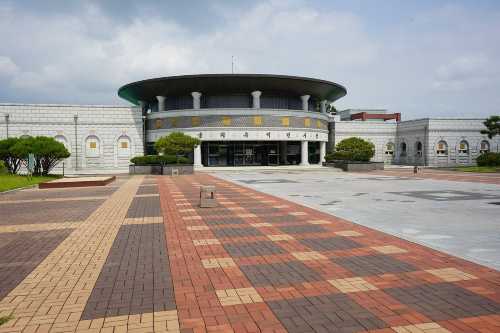App
Customer Support
NZD
Find Bookings
Popular Trip Moments
Iksan Bakery Pilgrimage Must-Visit Spot!! Bakery Cafe Hello. | Glims Coffee Roasters: A Unique Cafe in Iksan | A unique bakery cafe reminiscent of Harry Potter | Gosrak Ewha Garden: Enjoying Organic Sauces and Nature | Gosrak Ewha Garden, a space where 5,000 jars come to life | Iksan Gosrak, where 5,000 jars breathe. | A Korean Restaurant with 5,000 Living Jars, Gosrak | 🏰 Time travel from Buyeo and Iksan, Baekje Historic Sites! ⏳✨ | Iksan Wonkwang University with cute Toka pottery💜 | Iksan Shinsang Bakery Cafe | Iksan Wonkwang University Museum with special exhibition✈️ | A large-scale Iksan Museum with three floors🙇♂️ | Iksan Shinsang Bakery Cafe | Train Station-Themed Unique Cafe 'Geumjong Bakery' | Spring trip to Wonkwang University to feel the university campus🥰 | ‘Glims Coffee Roasters’, a cafe remodeled from a mill | Iksan Moonlight Sora Arboretum, a great place to see camellia flowers | Medieval European atmosphere cafe ‘Cote d’Or’ | Places to visit for a 2-day, 1-night trip to Iksan | Recommended large cafes in Ungpo | A winter cafe trip to Iksan with a clean interior🥳 | Iksan emotional cafe with various desserts😍 | A trendy bakery that recently opened in Iksan😍 | A trip to Iksan that feels like a time machine trip 🤩 | Winter bakery trip to Iksan🥰 | A great cafe trip to Iksan with your girlfriend in spring 🤩 | A trip to a large cafe in Iksan that is great for winter🤩 | Iksan Shelter where you can meet and read various books🥰 | Iksan outdoor date spot to enjoy in a happy space🥳 | This is a unique cafe in Iksan with an attractive wooden interior😍
Recommended Attractions at Popular Destinations
Bangkok attraction near me | Manila attraction near me | Tokyo attraction near me | Taipei attraction near me | Hong Kong attraction near me | Seoul attraction near me | Kuala Lumpur attraction near me | Los Angeles attraction near me | Shanghai attraction near me | New York attraction near me | Shenzhen attraction near me | Osaka attraction near me | Singapore attraction near me | London attraction near me | Guangzhou attraction near me | San Francisco attraction near me | Beijing attraction near me | Macau attraction near me | Bali attraction near me | Jakarta attraction near me | Paris attraction near me | Ho Chi Minh City attraction near me | Istanbul attraction near me | Phuket attraction near me | Chicago attraction near me | Seattle attraction near me | Toronto attraction near me | Orlando attraction near me | Cebu attraction near me | Chiang Mai attraction near me
Popular Attractions
Hanamikoji Street | Kaili Miao-Dong Customs Park | Hong Kong Disneyland | Tianmen Mountain National Forest Park | Shiqian Ancient Hot Springs | Kiwi Park Queenstown | Xijiang Qianhu Miao Village | Century Park | Sydney Tower Eye | Wellington Cable Car | Christchurch Botanic Gardens | Pingyao Ancient City | Shanghai Science and Technology Museum | St Henry's Garden salaama rd | El Viejo Ilalo | Residence of Bruce Lee | 168 Stairs | Terminal Bersepadu Selatan | Ecuries du château de Chaumont-Laguiche | Main Gate of Roshanara Park | Krestyansky Dom PLC Exhibition Center | Castillo de Narboneta | Meldi Maa Mandir, Dudheshwar | Kirche Am Kalvarienberg | Clyde Grand Reserve | Scottsville Free Library | Masjid Nurul Iman | Kids Fun - Arung Jeram | Lake Ashi | Shiping Mountain Scenic Area
Popular Restaurants in Iksan-Si
Ground | Cafe Di and Di | JukStory Iksan Eoyang Store | Coffee Myeongga | Gongcha | Mano430 | 7 Street Raw Meat | Mcdonalds | Starbucks IkSan Yeongdeung | Chamhan-U | Syaron Restaurant | Pancake Ju Nammun Native Sundae Soup | Coffee Ni | Maenhatan | Npub 앤펍 | Minsogchon | 올댓뮤직 파머스브루어리 sports pub & live music | Revival | 오가네장뇌삼한방백숙 | Kino | Hana Yori Dango (Japanese) | Mar Rueda | Coffee Belt | Chahyang-Gi | Malg eum | CONCEPT1 | Gui쟁이 원광대점 | Dutumdutum | Elbegang | nun-kkoch-tteul
Popular Ranked Lists
Popular Luxury Hotels Near Grad Korcula | Top 4 Best Things to Do in Changji Prefecture | Top 10 Local Restaurants in Kathmandu | Popular Premium Hotels in En Gev | Popular Premium Hotels in Fahaheel | Top 10 Local Restaurants in Sao Paulo | Top 10 Local Restaurants in Boston | Popular Best Things to Do in Shangqiu | Popular Premium Hotels in Port Harcourt | Popular Premium Hotels in Phuc Yen | Popular Best Things to Do in Shaoyang | Popular Premium Hotels in Miches | Top 9 Local Restaurants in Colombo | Popular Best Things to Do in Leye | Top 4 Best Things to Do in Dongfang | Popular Luxury Hotels Near Kongsberg | Popular Premium Hotels in Sestroretsk | Popular Premium Hotels Near Kamyzyaksky District | Top 10 Local Restaurants in Jakarta | Popular Luxury Hotels in Malargue | Top 10 Local Restaurants in Tel Aviv | Popular Luxury Hotels Near Sandakan | Top 10 Local Restaurants in Cebu | Popular Best Things to Do in Yangquan | Popular Best Things to Do in Jinchang | Top 6 Local Restaurants in Semporna | Popular Luxury Hotels Near Bridgewater | Top 10 Local Restaurants in Perth | Top 10 Local Restaurants in Belgrade | Top 10 Local Restaurants in Cairns
Payment Methods
Our Partners
Copyright © 2025 Trip.com Travel Singapore Pte. Ltd. All rights reserved
Site Operator: Trip.com Travel Singapore Pte. Ltd.
Site Operator: Trip.com Travel Singapore Pte. Ltd.






















